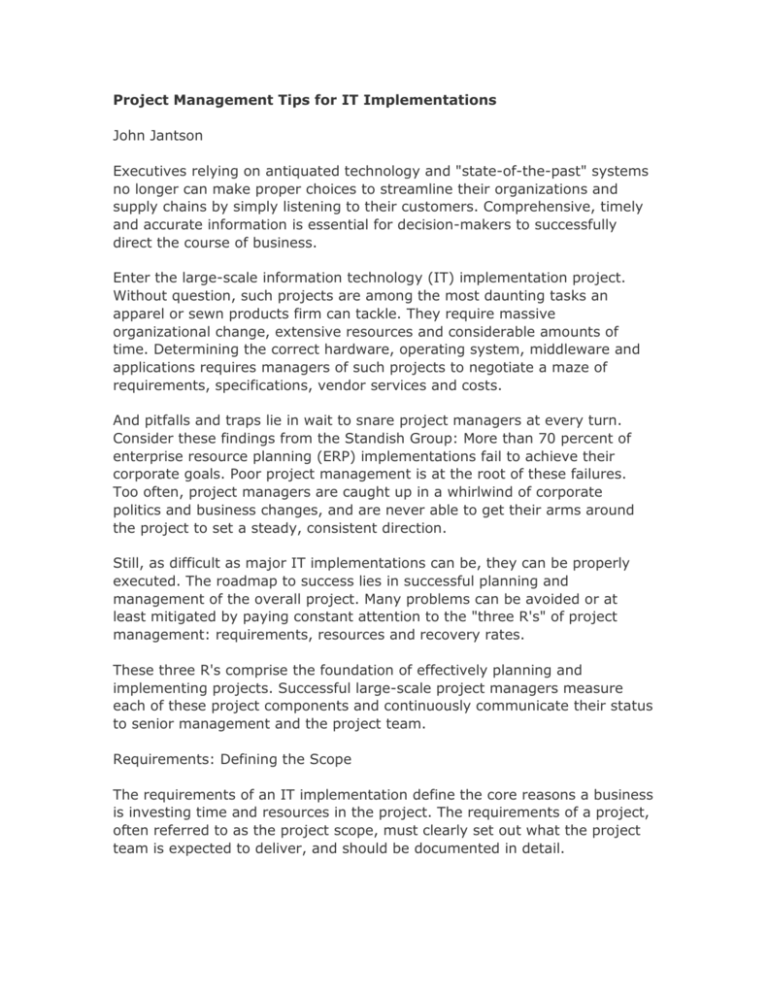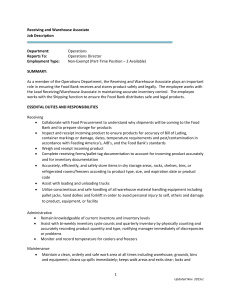Project Management Tips for IT Implementations
advertisement

Project Management Tips for IT Implementations John Jantson Executives relying on antiquated technology and "state-of-the-past" systems no longer can make proper choices to streamline their organizations and supply chains by simply listening to their customers. Comprehensive, timely and accurate information is essential for decision-makers to successfully direct the course of business. Enter the large-scale information technology (IT) implementation project. Without question, such projects are among the most daunting tasks an apparel or sewn products firm can tackle. They require massive organizational change, extensive resources and considerable amounts of time. Determining the correct hardware, operating system, middleware and applications requires managers of such projects to negotiate a maze of requirements, specifications, vendor services and costs. And pitfalls and traps lie in wait to snare project managers at every turn. Consider these findings from the Standish Group: More than 70 percent of enterprise resource planning (ERP) implementations fail to achieve their corporate goals. Poor project management is at the root of these failures. Too often, project managers are caught up in a whirlwind of corporate politics and business changes, and are never able to get their arms around the project to set a steady, consistent direction. Still, as difficult as major IT implementations can be, they can be properly executed. The roadmap to success lies in successful planning and management of the overall project. Many problems can be avoided or at least mitigated by paying constant attention to the "three R's" of project management: requirements, resources and recovery rates. These three R's comprise the foundation of effectively planning and implementing projects. Successful large-scale project managers measure each of these project components and continuously communicate their status to senior management and the project team. Requirements: Defining the Scope The requirements of an IT implementation define the core reasons a business is investing time and resources in the project. The requirements of a project, often referred to as the project scope, must clearly set out what the project team is expected to deliver, and should be documented in detail. For example, a project manager may be assigned to implement a data warehouse. The definition for this project could be several pages long, and should include the following types of statements: * "The project team will implement ABC Software Co.'s data warehouse without any modifications to the base application." * "The data warehouse will be deployed to the following groups of users: sales and merchandising, production planning and warehousing/distribution managers." In the beginning of a new project, many of these details can be unknown quantities, and it might seem impossible to define specifics. A project manager may encounter feedback such as: "We cannot limit the implementation of the new data warehouse just to these departments. We may need to deploy it to members of the accounting, sourcing and marketing departments." Although this statement might be accurate, the project manager should not add to the project's scope without documenting the additional needs. For example, if additional user groups are to be included, the documentation about the project's scope should be amended with a statement such as the following: * "The project team will identify the users that require access to the new data warehouse." By accurately documenting the work that needs to be done, the project manager can provide senior management with a better understanding of the time frames and resources that will be required to complete the project. Prior to commissioning a major initiative, senior management should require the project team to complete a cost/benefit analysis. This analysis should outline high-level deliverables that will result from the project meeting its goals. The project team also should define metrics and benchmarks that can be used to measure the benefits of change and the progress and completion of each deliverable. For example, if a new system is being deployed that reduces the time required to print, sort and attach hangtags, the current amount of time required to complete these activities must be accurately benchmarked. After the new system has been deployed, management can compare the new tagging time requirements against the historical benchmarks and quantify the amount of time saved. Resources: Set Goals But Be Flexible The second of the 3 R's -- resources -- includes all employees, consultants and vendors who are required to successfully complete the project. Resources also encompass the budgets, capital expenditures, equipment and infrastructure necessary to achieve the requirements of the project within the target time frame. Resources are the most important commodities of the project. Without them, none of the project requirements will be completed. They also can be the most difficult aspect of a project to accurately pinpoint. In determining the amount of resources that will be required to complete a project, many base their calculations on the firm's number of full-time employees (FTEs). Deriving an accurate FTE count, however, can be a difficult task. Thousands of variables change the resource requirements of major projects on a daily basis. People become ill, quit, go on vacations and take maternity or paternity leave. When establishing an estimate for a project, the project manager must consider the amount of work that needs to be completed and put a stake in the ground in terms of the resources that will be required to do the job. As the project progresses, it is important that the project manager revisit the original estimates with updated information, and adjust his or her team's size, budget projections, etc. accordingly. Recovery Rate: Measure the Milestones The recovery rate can be measured from the time any requirements of the project are completed through the time the business begins to recover its capital investment. A classic mistake of many project managers is to focus 100 percent on the end of the project. If project managers do not develop and manage interim milestones, they are unable to determine the rate at which they are achieving project requirements. As a result, they are not able to clearly determine whether the project is on time and if it will meet the deadline. In the end, requirements, resources and recovery rates must all be carefully balanced to successfully realize the benefits of a large-scale project that is on time and meets budget. As changes occur, it is imperative that the project manager identifies which of the three R's each change affects. When a project is in balance, any change to one of the three R's will cause a compensatory change in another. For example, as requirements are added to a project, either additional resources or additional time must be added to the initiative. The project manager's responsibility is to qualify the effect of the change and express these effects to senior management. By utilizing the three R's approach, project managers are able to set and manage the expectations of senior management and the organization, and manage the overall project toward success. As innovative technology continues to change, businesses need to adapt at an increasingly fast rate, and must be able to successfully implement major IT projects to stay in the game. John Jantson has more than five years of experience as a manager and consultant with Kurt Salmon Associates (KSA). During that time, he has worked in all phases of the software development and implementation lifecycle, with an industry focus in retail and consumer products. COPYRIGHT 2000 Miller Freeman, Inc. COPYRIGHT 2000 Gale Group










